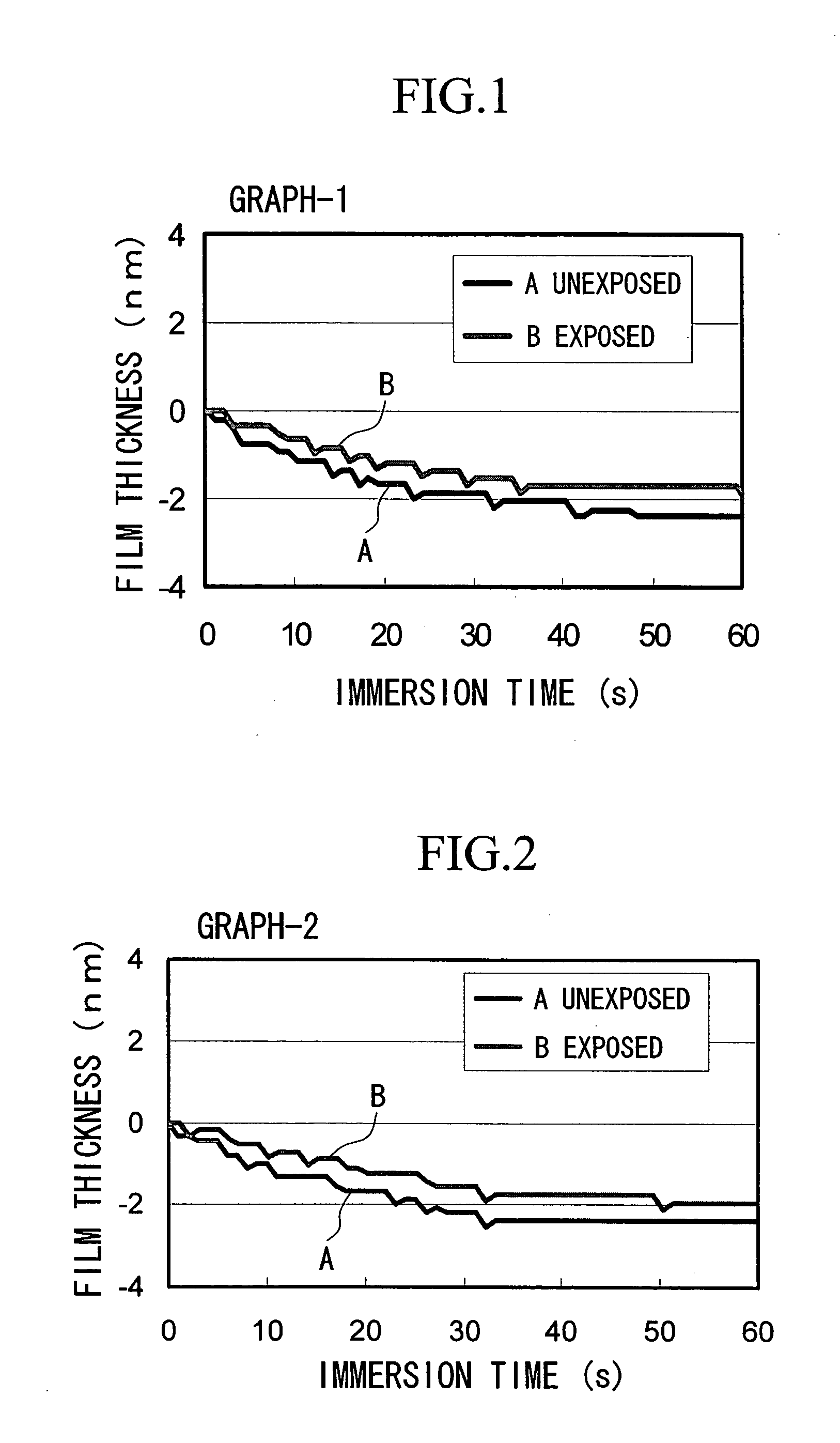Resist composition
a composition and resist technology, applied in the field of resist compositions, can solve the problems of reducing the wavelength of light sources, reducing the depth of focus range, altering the refractive index of solvents, etc., and achieves the effects of low sensitivity, low cost and low swelling
- Summary
- Abstract
- Description
- Claims
- Application Information
AI Technical Summary
Benefits of technology
Problems solved by technology
Method used
Image
Examples
example 1
A component (A), a component (B) and a component (D) described below were dissolved uniformly in a component (C), yielding a positive resist composition 1.
As the component (A), 100 parts by weight of a methacrylate-acrylate copolymer comprising the three structural units shown in the [formula 21] was used. The proportions p, q and r of each of the structural units used in preparing the component (A) were p=50 mol %, q=30 mol % and r=20 mol % respectively. This copolymer contained no structural units containing an anhydride of a dicarboxylic acid, and no structural units containing a phenolic hydroxyl group. The weight average molecular weight of the thus prepared component (A) was 10,000.
As the component (B), 3.5 parts by weight of triphenylsulfonium nonafluorobutanesulfonate and 1.0 parts by weight of (4-methylphenyl)diphenylsulfonium trifluoromethanesulfonate were used.
As the component (C), 1900 parts by weight of a mixed solvent of propylene glycol monomethyl ether acetat...
example 2
A component (A), a component (B), a component (D) and the other component described below were dissolved uniformly in a component (C), yielding a positive resist composition 2.
As the component (A), 100 parts by weight of a methacrylate copolymer comprising the three structural units shown in the [formula 22] was used. The proportions p, q and r of each of the structural units used in preparing the component (A) were p=40 mol %, q=40 mol % and r=20 mol % respectively. This copolymer contained no structural units containing an anhydride of a dicarboxylic acid, and no structural units containing a phenolic hydroxyl group. The weight average molecular weight of the thus prepared component (A) was 10,000.
As the component (B), 2.0 parts by weight of (4-methylphenyl)diphenylsulfonium nonafluorobutanesulfonate and 0.8 parts by weight of tri(p-tert-butylphenyl)sulfonium trifluoromethanesulfonate were used.
As the component (C), 700 parts by weight of a mixed solvent of propylene glyco...
example 4
A resin component comprising a repeating unit represented by a chemical formula shown below
(wherein, m:n is 84:16 (mol %)), 10% by weight, relative to this resin component, of a water insoluble cross linking agent formed from tetrabutoxymethylated glycoluril, 1% by weight of an acid generator formed from triphenylsulfonium nonafluorobutanesulfonate, and 0.6% by weight of an amine component formed from 4-phenylpyridine were dissolved in propylene glycol monomethyl ether, yielding a negative resist composition with a solid fraction component of 8.1% by weight.
Meanwhile, an organic anti-reflective film composition AR-19 (manufactured by Shipley Co., Ltd.) was applied to the surface of a silicon wafer using a spinner, and was then baked and dried at 215° C. for 60 seconds on a hotplate, thereby forming an anti-reflective film layer with a film thickness of 82 nm. The negative resist composition obtained above was applied on top of the anti-reflective film using a spinner, and was ...
PUM
| Property | Measurement | Unit |
|---|---|---|
| thickness | aaaaa | aaaaa |
| width | aaaaa | aaaaa |
| thickness | aaaaa | aaaaa |
Abstract
Description
Claims
Application Information
 Login to View More
Login to View More - R&D
- Intellectual Property
- Life Sciences
- Materials
- Tech Scout
- Unparalleled Data Quality
- Higher Quality Content
- 60% Fewer Hallucinations
Browse by: Latest US Patents, China's latest patents, Technical Efficacy Thesaurus, Application Domain, Technology Topic, Popular Technical Reports.
© 2025 PatSnap. All rights reserved.Legal|Privacy policy|Modern Slavery Act Transparency Statement|Sitemap|About US| Contact US: help@patsnap.com



